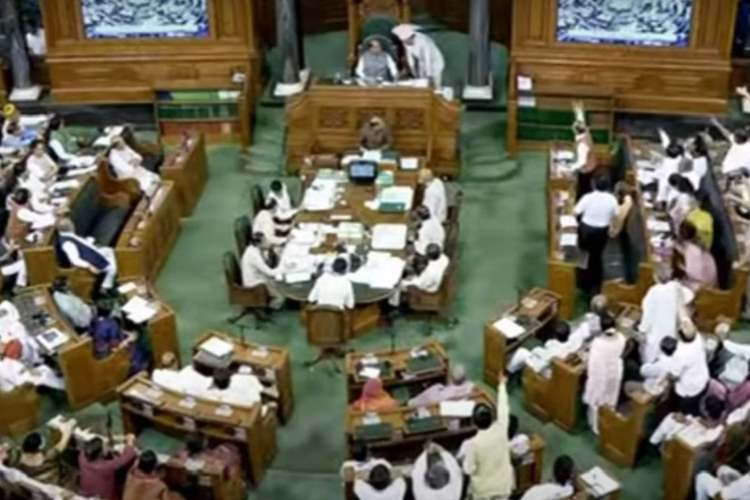
The Women’s Reservation Bill which stipulates a 33% quota for women in the Lok Sabha and state assemblies has been passed in the Lok Sabha during the current special session of Parliament. Prime Minister Narendra Modi had appealed to the Opposition to unanimously pass the “Nari Shakti Vandan Adhiniyam” Bill, which has been pending for nearly 30 years. His call was answered and 454 MPs voted in favor of the Bill. As the inaugural bill presented in the new Parliament building, Modi emphasised its potential in enhancing women’s involvement in state and national policymaking. He said this could be a stepping stone toward achieving India’s vision of becoming a developed nation by 2047.
Despite women comprising almost half of India’s 950 million registered voters, their representation remains low across sectors. Women constitute a mere 15% of Parliament and around 10% of state legislatures. The Bill’s introduction might be a turning point in addressing this situation.
READ | OECD Economic Outlook flags stagflation as nations battle inflation, low growth
Once the Bill secures approval from both Houses, it will hold the distinction of being the first legislation passed in the new Parliament building. The government estimates suggest that female representation in the Lok Sabha will surge to 181 from the current 82. Many political parties are vying to leverage this bill for their advantage. Congress leader Adhir Ranjan Chowdhury credited his party for initiating the women’s quota, noting that the Congress-led governments under Rajiv Gandhi, PV Narasimha Rao, and Manmohan Singh had made persistent efforts to pass such a legislation.
Provisions of Women’s Reservation Bill
The Women’s Reservation Bill outlines the addition of three new articles and one new clause to the Constitution. Among these, a new clause in 239AA stipulates the reservation of seats for women in the Delhi Legislative Assembly. Another significant article, 330A, mandates that one-third of the seats in the Lok Sabha and state Legislative Assemblies, including those reserved for SCs and STs, be reserved for women.
Proponents believe that such affirmative action can elevate women’s status and representation in Parliament. However, critics argue that reservations contradict the Constitution’s promise of equality, asserting that women are not a monolithic entity and that such policies might disrupt traditional familial structures.
Tracing the history of women’s reservation in India, the concept of a democratic setup and universal adult suffrage initially raised hopes for inclusive representation. Nonetheless, these expectations remained unmet, leading to growing demands for reservations. The journey began in 1996 when the Deve Gowda-led United Front government first introduced a similar bill in the Lok Sabha, which unfortunately did not gain House approval.
Subsequent endeavors to reintroduce the bill in 1998, 1999, 2002, and 2003 saw bipartisan support, but it never secured the requisite majority. A pivotal moment arrived in 2010 when the Manmohan Singh-led UPA government managed to get the bill passed in the Rajya Sabha. Yet, it never saw the light of day in the Lok Sabha and eventually lapsed in 2014.
In 2013, the Ministry of Women and Child Development set up a committee to evaluate the status of women. This committee advocated for a 50% reservation for women across various governmental decision-making bodies.
The urgency of addressing women’s reservations is underscored by data indicating that numerous state assemblies have female representation below 10%. As per December 2022 government statistics, states like Chhattisgarh, West Bengal, and Jharkhand, although leading in terms of women MLAs, still register unimpressive figures of 14.44%, 13.7%, and 12.35%, respectively.
While the Bill has huge vote catching potential, political support to the legislation is a difficult proposition. Modi may find it difficult to convince his NDA allies on the merits of the Bill because of caste factors that are in play. Another issue is the presence of popular leaders such as Arvind Kejriwal, Naveen Patnaik and Mamata Banerjee among opposition ranks who could swing the quota system in their favour.
In the evolving democratic tapestry of India, the Women’s Reservation Bill emerges as a significant step toward rectifying gender imbalances in political representation. Despite constituting nearly half of the nation’s electorate, women’s representation in pivotal legislative domains has been glaringly disproportionate. The introduction of this bill, which has seen multiple iterations over the decades, underlines the nation’s commitment to upholding gender equality and inclusivity.
The bipartisan support it has garnered over the years, coupled with the contemporary push for its passage, reflects a broader consensus on women’s pivotal role in shaping India’s future. However, the success of such legislation will not solely rest on numbers or quotas but on the tangible changes it catalyses in policymaking and governance. The bill’s introduction and possible passage may not only rectify historical disparities but also pave the way for a more equitable and progressive Indian polity.

